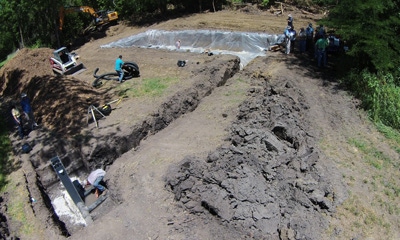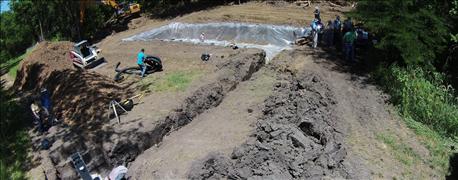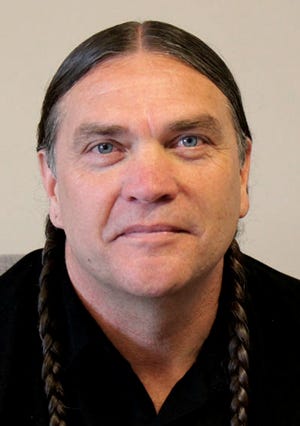
The Illinois Nutrient Loss Reduction Strategy was released more than a year ago by the Illinois Environmental Protection Agency and the Illinois Department of Agriculture. Prairie Farmer caught up with Ivan Dozier, state conservationist for Illinois’ Natural Resources Conservation Service, for an update on conservation practices and how Illinois farmers are making progress toward that nutrient loss reduction goal.
PF: There have been countless meetings that covered the ILNLRS this winter, spring and summer. Are we still in the education phase, or are we moving to the implementation phase?

BIOREACTORS: A woodchip bioreactor is one of the new practices recommended in the Illinois Nutrient Loss Reduction Strategy. Tile drainage is routed to a woodchip-filled trench where bacteria naturally convert nitrates into nitrogen gas.
Dozier: Overall, we’re still in that education phase. When you look at field drainage tile for more than 100 years, especially in this flat topography where we have those heavier soils, we’ve worked particularly hard to drain those soils as a management practice, a production practice. And anything that messes with that, it’s going to take a little bit of time to understand.
But I’m really excited about this education phase — that there so many conservation practices that can be used, and people are getting out there for field demos, and we’re getting more research on these practices and how they work.
And people are interested, so that’s always a good start.
PF: The ILNLRS offers several different practice recommendations: bioreactors, saturated buffers, constructed wetlands and drainage water management. How can farmers determine which practice may work best on their operation?

ON THE RIGHT TRACK: “I have seen so much interest from farmers trying to understand how those applied nutrients are leaving the field and trying different techniques to interrupt that pathway of those nutrient losses,” says Ivan Dozier, state conservationist. “Even before the strategy came out in Illinois, farmers were already starting to pay attention to this.”
Dozier: That’s the thing with any conservation practice: There is no one-size-fits-all. The soil types are different, the topography is different, the crops you plant and how you apply fertilizer is different. And we’re just now starting to understand a little bit more about how some of these things work.
We always talk about balance between production and conservation. As we learn more about it, that’s where we’re starting to see some of the newer practices from the strategy.
The denitrifying bioreactor is one of those options. There’s drainage water management that we’ve been working on for several years that interrupts the tile drain throughout the season. [For] the saturated buffers, we now have a standard out, and it’s been added to the approved incentive payment list. You use some of those buffers that are in place, and the water parks there under the buffer. Constructed wetlands — they’ve been around for a while, but now we’re sizing them specifically for the discharge of tile, instead of into a ditch or stream. The discharge goes into a designed wetland to help remove contaminants.
We’re trying to understand how these contaminants work in the environment and trying to find a way to interrupt them in a way that doesn’t have an adverse effect on our farm productivity.
PF: Which practice or practices do you see as the best options for Illinois farmers?
Dozier: The denitrifying bioreactors are buried underground and not in the way. I think that one is really getting a lot of attention. The constructed wetlands take up some land area, so you have to have the right place for it. The saturated buffers, you have to have a buffer, and again, you have to have the right topography.
The denitrifying bioreactors and the drainage water management, I think, have the best opportunity to work with the least amount of maintenance, but they are big steps. The topography still has to be right, and the type of tile draining into it has to be right.
PF: What do farmers need to consider before moving forward with one of these recommended practices?
Dozier: One thing I keep talking about is topography. These types of practices really work on land that is fairly level.
And that’s another unique thing that makes a difference with practice adoption. Traditionally, in the past, we’ve worked a lot with soil erosion. And even the water quality end of it, it’s been from the aspect of sediment as the contaminant. So now, here we are on flat to gently sloping land. As far as conservation issues, we haven’t worked a lot with those farmers. So that topography, fairly level ground, that’s where we have the most field tile. And the practices work best with pattern tile drainage.
PF: You just mentioned soil erosion; why are there fewer conversations about soil erosion compared to 20 years ago?
Dozier: I think we’re doing a better job.
Soil is still the No. 1 contaminant of water, but we’re doing a better job. We’ve seen people adopt some of those conservation practices. In fact, the thing we used to call conventional tillage was moldboard plowing. And you can’t even call that conventional tillage anymore. Now there is some type of conservation tillage, usually a chisel plow, leaving some kind of residue on the surface, and that has replaced moldboard plowing as conventional tillage. That lexicon has completely changed, and we’re doing a better job.
The nutrient loss reduction strategies popping up all over the Corn Belt have also caused a shift in attention. The good news is that a lot of things we can do to help with soil erosion also help with nutrient loss reduction.
Cover crops, soil health, anything that helps improve the infiltration — those are good soil conservation practices, and they can also help reduce nutrient losses.
PF: What are Illinois farmers doing well in terms of conservation and nutrient loss reduction?
Dozier: No-till is one of those things. Even on some of the flatter ground, no-till and strip till can work as a conservation platform on both level and flat ground.
And then farmers are adjusting nutrient applications and making precise nutrient applications. They are paying more attention to the 4 R's: the [right] timing, the [right] type, the [right] amount and making sure it’s in the right place. Those kinds of things are really making a difference.
And farmers are paying attention to those nutrient pathways. I have seen so much interest from farmers trying to understand how those applied nutrients are leaving the field and trying different techniques to interrupt that pathway of those nutrient losses. Even before the strategy came out in Illinois, farmers were already starting to pay attention to this.
The ILNLRS does have a little of that stick behind it, too. But having time to try these things and see what works — I’m watching the farmers, and they are really actively addressing these issues, and it’s an encouraging sight.
PF: What can farmers do better?
Dozier: They’ve looked at the big picture and seen the practices. Now what they need to do is get that prescription together right down to the field level, so we know what those pathways are or what they can be, and determine what they need to do right in this field and get the right prescription for that farm.
PF: Are the goals outlined in the ILNLRS achievable?
Dozier: I’ve seen more awareness out there. It’s a big shift.
What we’ve been thinking about and how we farm in Illinois, we haven’t had a lot of regulation. No one really wants that, and that thought gets people’s attention. That’s the stick.
I think we have the tools — those conservation practices that can be used, a wide variety from one end of the state to the next. And it’s going to take a little time to understand them, and time to get them out into the landscape. It’s going to take some real change. But I think it’s achievable.
PF: So we’re on the right track. What’s your message for Illinois farmers moving forward?
Dozier: Don’t stop. Don’t get complacent. Don’t just sit back and think, I’m just going to wait and see what happens. Stay involved.
There are a lot of groups out there, everything from conservation groups to production groups, that are on board. They are all trying to help and address this issue and tackle it head-on, so there are lots of opportunities to learn.
Let’s keep this momentum going, and let’s show everybody that Illinois farmers really are interested in this.
PF: Is there anything else farmers should keep in mind?
Dozier: With tile, specifically, just a reminder that conservation compliance provisions are part of the farm bill for USDA participants. If farmers are going to install a drainage system that wasn’t there before, or put in deeper, closer or larger tile, come in, sign the paperwork and have those areas evaluated.
I don’t want to get anyone crosswise with conservation compliance as they are trying to address the strategy. Get in and sign that form AD-1026. Before you put this tile in, I want to make sure it won’t cause an issue with wetland compliance.
About the Author(s)
You May Also Like




